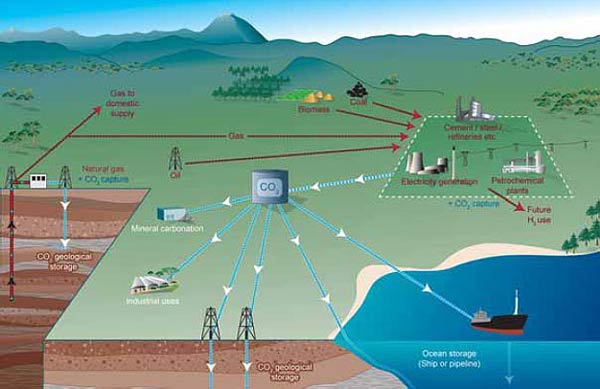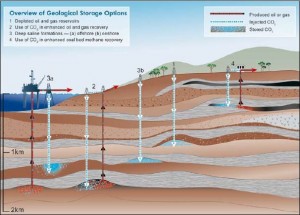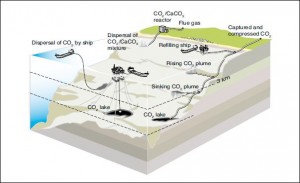Carbon Capture and Storage has three main parts: capture, transportation and storage.

Capture
The capture phase is the initial phase of the process. There are different times in the process that separation of the CO2 can be implemented for capture.
Post-combustion: Post-combustion capture separates the CO2 from the N2 and O2 after the fuel is burned and the electrical generation or industrial process is completed. Sorbents or solvents are used to separate the CO2. Those sorbents are then put through another process designed to cause the CO2 to be released. The pure CO2 is compressed, dehydrated and then transported.
Pre-combustion: Pre-combustion capture separates the CO2 in the fuel form. The CO2 is removed before the fuel is burned by a physical or chemical absorption process. Hydrogen-rich fuel is used to power the turbines, engines, etc. as opposed to the CO2 filled fuel. The CO2 removed from the fuel is then compressed, dehydrated and then transported
Oxy-fuel Combustion: Oxy-fuel combustion is using pure oxygen instead of air for the combustion process which results in flue gases that are pure CO2 after the dehydration process. This CO2 is compressed and transported.

Transportation
Transportation of CO2 started in the early 1970’s with a pipeline for enriched oil recovery (EOR). EOR is discussed more in the storage section below. Besides pipelines which are mostly used for consistent transportation of large quantities of CO2 and will be required for mass implementation of CCS. Liquid CO2 can be transported in ships, trucks or trains. Pipeline CO2 is in the “dense phase.” This means there is not a distinct phase change between liquid and gas.
Storage
There are multiple types of storage or uses for CO2. CO2 has been used for decades for EOR and other industrial processes. These uses can be used more readily because of increased capture of carbon if CCS is widely implemented. Other storage opportunities are geological storage, ocean story and mineral carbonation.
Geological Storage: Geological storage is the most attractive option for storage. Storage in the earth uses geological formations of porous rocks deep in the earth with a cap rock above it. The porous rock is where the CO2 is injected and the gas diffuses through the rock but is trapped by the cap rock that is not porous. There are multiple locations to do this. The following numbering refers to the figure that shows four CO2 geological storage options including EOR and enhanced coal bed methane recovery (ECBM).
1. Displays storing CO2 in a completely depleted oil or gas reservoirs. The oil and gas reservoirs are naturally designed to hold CO2.
2. Shows the use of the CO2 for EOR. This helps enhance oil extraction while simultaneously reducing CO2 emissions.
3. Deep saline formations act the same as depleted oil or gas reservoirs that contain CO2. (a) shows offshore (b) shows onshore
4. CO2 can also be used for ECBM or enhanced coal bed methane recovery.
Ocean Storage: CO2 is water soluble and therefore act as a storage opportunity for CO2. The oceans naturally store CO2 when the atmosphere has an excess of CO2 because the atmosphere and the oceans go towards equilibrium. The injected CO2 will cause this push the oceans towards equilibrium faster. The location of injections into the ocean are not arbitrary. There are several different formations in the oceans that are shown in the figure.
Mineral Storage: Mineral storage consists of using mineral carbonation. The two main reactions are CaCO to CaCO3 and MgCO to MgCO3. These minerals are then either disposed of or re-used in construction. This storage technique is not economically viable at this time and ocean, and geological storages are much more attractive for widespread CCS systems.
Resources:
Metz, Bert Ogunlade Davidson, Heleen de Coninck, Manuela Loos, IPCC Special Report on Carbon Dioxide Capture and Storage. IPCC, . 2005. Print.
Global CCS Institute. “Global Status of CCS 2011.”Global Carbon Capture and Storage Institute. Global Carbon Capture and Storage Institute, 4 Oct. 2011. Web. 15 Apr. 2014.
Written by: Michael Duncan
Edited by: Eric Gallant
